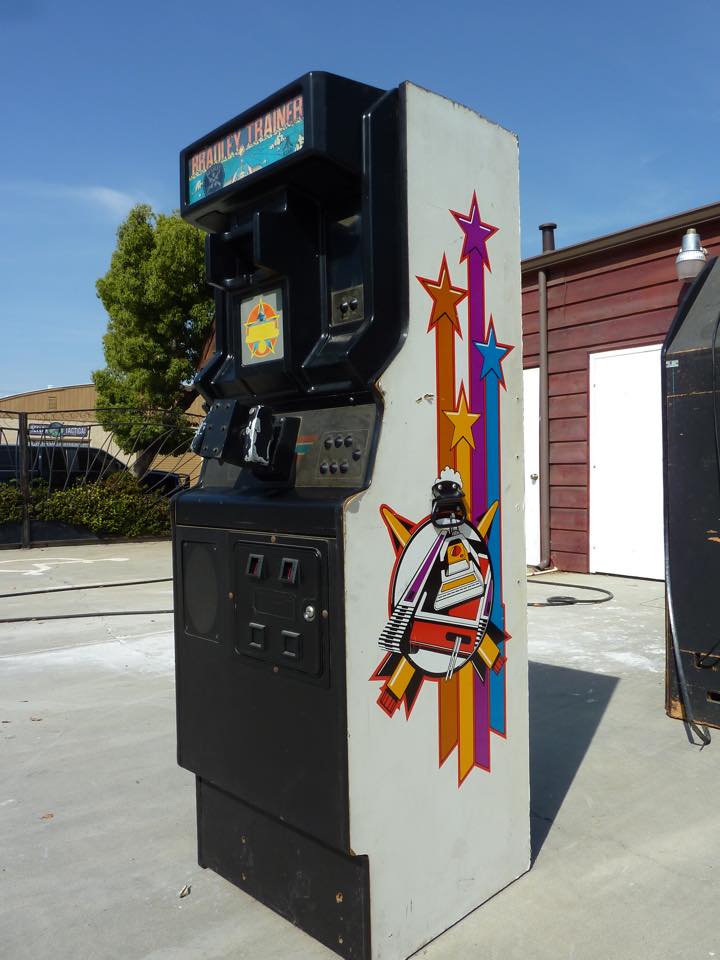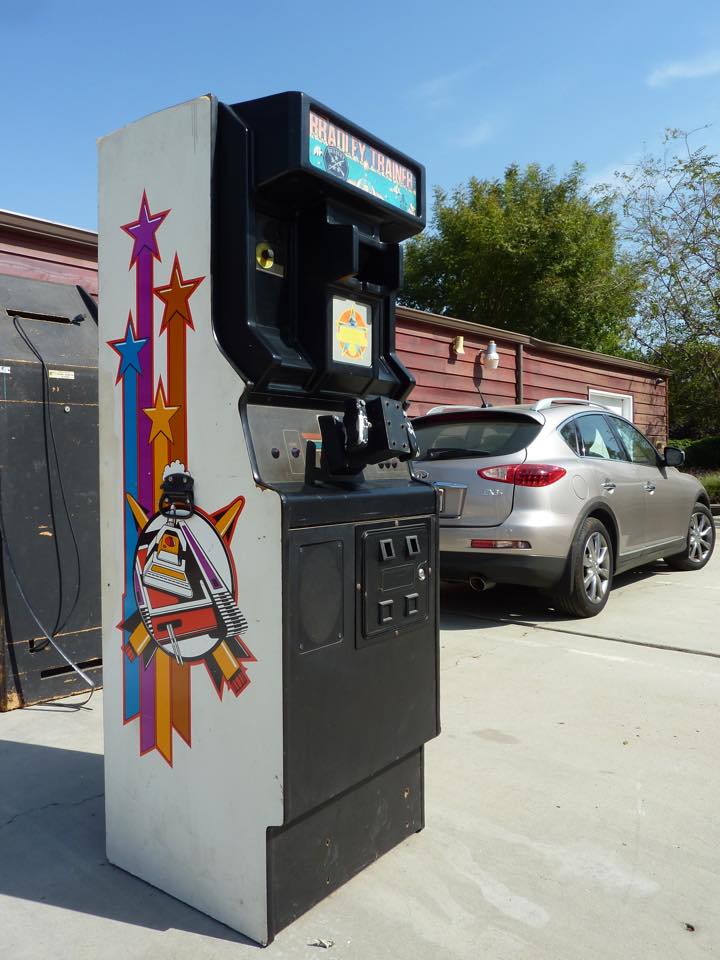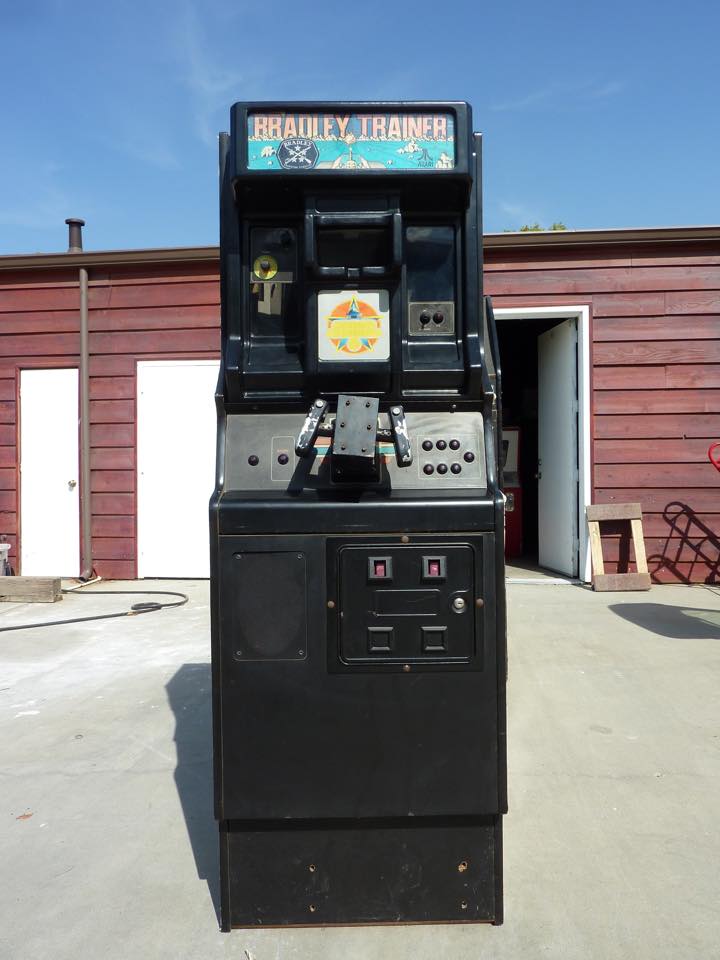Atari’s Battlezone arcade game released in 1981 was an immediate classic. This first-person wire frame vector shoot-em-up, puts the player at the controls of a tank wandering the wilderness of a futuristic-looking battlefield, shooting down enemy tanks, UFOs and missiles. Around 15,000 machines were rolled out of Atari’s factory in both upright and cabaret form.
Here, the final upright version of the cabinet included a periscope style interface that players looked through to play the game. This added to the illusion of actually being inside a tank:

An unexpected by-product of the game’s release was interest from the military. Training soldiers was an expensive business, especially using live rounds which in some cases would cost several thousand dollars apiece. The US Army was very interested in exploring ways in which new recruits could potentially be trained in a safe environment at a fraction of the cost. This is how the idea for what would become Bradley Trainer was born.
Much of the detail of this story is vague, part in view of its very nature, and until very recently much of the tale was regarded as folklore rather than fact. Shrouded in secrecy at the time, the project was certainly not business as usual for Atari, but clearly represented a large potential income stream that they wanted to pursue, and at some point in the future exploit to its maximum.
The story goes that after the release of Battlezone, a think tank made up of a group of retired Army officers, approached Atari with a proposition; could Atari adapt the Battlezone code to make it suitable for training new recruits? Specifically those who would be stationed within an Infantry Fighting Vehicle (later renamed the Bradley Fighting Vehicle after Omar Bradley, a distinguished Army General who died in 1981).
The development team working on the simulator were divided in their commitment to the project, and Atari’s management were far from forthcoming with details of the arrangement.

If Atari could deliver a prototype, the think tank acting as an intermediary between Atari and the US Army, would then pitch the simulator, and if successful, this would lead to a large order of completed games. Faced with the possibility of a bulk order of arcade hardware that didn’t require marketing investment to support it, Atari agreed to start work.
But first, they had to convince Ed Rotberg, the programmer of the original Battlezone game, to work on the new project. In an interview with Retro Gamer magazine in 2007, Ed recounts:
I’m a bit of a pacifist, so I didn’t really want to help train people to kill. Plus if you have a military contract the government can really impose a lot of restrictions on your company, which I didn’t think was healthy for Atari. But management were under the gun to get it done, so I agreed, as long as I was absolved of any future involvement once it was done.
This is a fair stance on the surface of it. Dave Theurer was absolutely insistent that Missile Command would in no way be offensive and only agreed to work on the game if it was essentially a defensive game at its core. Supposedly, Rotberg referenced the fact that many automotive factories during the time of World War 2 were re-purposed to produce airplanes and tanks. This was something he didn’t want to see happen to Atari.

But it’s worth pointing out here that the key point of working through a third-party was that Atari (and their owner Warner Communications Inc) wouldn’t become a defence contractor, removing potentially nightmarish due diligence requirements, and the release of financial accounts to the public domain. All of that would be handled by the intermediary think tank, leaving Atari to simply take an order for cabinets, produce them and bank a big fat cheque. On that commercial basis alone, the project was seen as worth pursuing.
A different view to Rotberg’s was taken by Jed Margolin, who worked on the project as an engineer:
I felt (and still feel) that I can be against war and still support our troops. When we send our troops into combat we are not sending them to give their lives for our country. We are sending them so the enemy troops can give their lives for their country.
This more objective stance was shared by the rest of the team: the project leader Rick Moncrief, (who headed up Atari’s Special Projects Group that went on to produce Star Wars and the Hard Drivin’ series), Hans Hansen who worked on converting real images of military hardware into vector graphics, and Otto De Runz, an engineer who was responsible for translating the real life controls of a Bradley vehicle into ones that were useable on the final product.

But there was an air of uncertainty about the project throughout the company. Many engineers believed out of principle that video games should play no part in military activity. Post Vietnam, there was a great deal of anti-war sentiment throughout the USA, and it would be fair to assume that this would have been reflected throughout the corridors of Atari during the early 80s.
Against this backdrop, the team were under pressure right from the start. The project needed to be delivered within ten months, and the plan was for the simulator to be showcased at a military conference during 1981 by the intermediary.
The new “game” was initially referred to as “Army Battlezone”. Many changes were made to the original code of Battlezone so that it better reflected the nuances of a Bradley Fighting Vehicle.
The controls were a major consideration. Where Battlezone used twin sticks as an interface, Bradley Trainer used an adapted gunnery yoke that allowed the user to aim across both an x and y axis. This better represented the controls used within the real Bradley Vehicle.

You’ll notice many similarities between this early yoke and what would become the flight yoke on Atari’s later release Star Wars and later Road Blasters.
The Battlezone code itself was heavily adapted too. The gameplay (if we can call it that) removed the need to “Drive” the vehicle. As Rotberg explains:
It was meant to be a casual training device for the Infantry Fighting Vehicle, so you’d be able to recognise the silhouettes of friends as opposed to foes.
Given Ed’s stance on the project, presumably anything more gung-ho would have meant removing himself from the project. But players could still shoot enemies:
Weapons we included were a machine gun, armour-piercing, and incendiary shells and a TOW missile that required the trainee gunner to keep crosshairs fixed on the target after firing. ‘You had to fire on a trajectory not a straight line,’ adds Ed, ‘and we put in a x3 and x12 magnification control like in the real gunner station.
These weapon changes were significant.
The game placed the trainee as a gunner inside the Bradley Vehicle. Having successfully identified an enemy target, the player had to decide how to destroy it using one of the weapons mentioned above. Delivering friendly fire against your own side would end the game.

Using the armour-piercing and incendiary shells required management of the cannon. This was a complex piece of equipment involving estimating the size and distance of the target, adjusting a potentiometer dial to compensate, and firing. All that after selecting which of the two weapons you were going to use of course.
If using the TOW (Tube-launched Optically guided Weapon), players had to fire off the weapon, and then follow through by steering the missile with the yoke until it hit the intended target.
Bradley Trainer was deliberately harsh, intended to replicate the unforgiving nature of the battlefield. A key objective was to destroy enemies with your first shot. The enemies would react if not hit with the first shot – so accuracy was key.

Compare this to the original Battlezone game, which had one weapon and only three enemy types, you can see it had shifted very much more into a more complex simulator.
Relieved at the end of the project, Ed Rotberg allowed the game to be taken away some ten months later (two prototypes were allegedly built) to be demonstrated at the aforementioned conference. Incredibly, once finished, the simulator actually made local ABC news channels in August 1981. The cabinet is shown, someone representing the army is interviewed, and there’s even gameplay footage:
What happened after that is pure speculation. Many believe the project went no further. After all, how would Atari manage to build hundreds of Bradley Trainers without making its uneasy staff aware of the controversial game? Components would need to be built, cabinets constructed and then shipped out of the factory to destinations all over the country. As Jed puts it:
Now that I think of it. If someone had made a bunch of them, you would think that by now someone would have come forward and said, “I was a Bradley Gunner when I was in the Army and I learned to fire TOW Missiles on a thingie that looked a lot like BattleZone.”
But I’ll add to the mystery, and quote this excerpt from Bruce Schachter’s 1983 book, Computer Image Generation:
The Army’s Training and Doctrine Command (TRADOC) has completed an extensive study of arcade game technology and its application to military instruction. Under contract to TRADOC’s training support center, Atari had modified their popular “Battlezone” game into “Army Battle Zone” in which the controls and weapons of the M2 infantry fighting vehicle are replicated. Army experts who have worked with the game find it to be a useful tactical trainer; a more sophisticated version is in the works.
The conspiracy theorists point out that is is possible that Atari physically removed the whole project from its headquarters, licensed the build with another 3rd party, and delivered thousands of completed Bradley Trainers to the US Army. Although I find it hard to subscribe to this theory, as one would assume that instances of those cabinets would have turned up by now. My best guess is that the two prototypes were produced, but the project went no further for reasons unknown.

Whilst researching this piece, I found a cached web page from 1991, where Ed Rotberg was asked about the game on a video game bulletin board. Here’s some of what he said:
I lost 3 months of my life (I’m not exaggerating much here) doing this project under duress. I know of only one surviving unit, and I’m not about to divulge its whereabouts. I thought if I answered this post, I might stem the flurry of debate on a subject I’m not particularly fond of so……….
PLEASE, PLEASE, PLEASE, Drop the subject
This is not for any security reasons, it’s just literally a painful subject!!!
This is interesting on two points:
- He clearly worked on Bradley Trainer reluctantly
- He was aware of one unit still existing somewhere back then
But incredibly, one of the two prototype Bradley Trainer cabinets has surfaced. Collector Scott Evans found one next to a dumpster outside the closed offices of Midway Games sometime around 2003. The other is presumed lost after being sent to demo to the army.
Do have a look at this page where Scott goes into some detail about the cabinet and shares some detailed pictures of the PCB and controls.
The following pictures were taken at the California Extreme event in 2004 where Scott kindly displayed the Bradley Trainer he had found. Apologies I can’t credit these pics as I don’t know who took them, but they do show the remarkable detail of this cabinet:


Truly a unique piece of arcade history.
Interestingly in 2017, I came across these Polaroids in a random file at the Strong Museum in Rochester who acquired several pallets of old Atari documents. They depict what appears to be the marquee of the Bradley Trainer machine, but sporting the title “Army Battlezone”:

The Bradley Trainer’s ROM has been dumped to the MAME system. This video gives a feel of the game, but one would imagine it is very difficult to play given the complex control layout of the original hardware:
Clearly much of the story behind Bradley Trainer has been lost to the mists of time; it would be fascinating to hear from someone within the think tank, or Atari Management who brokered the discussion. Folklore, rumour and speculation remains, but what we do know does give a great insight into the development of this very unusual piece of arcade-based hardware.
Update October 2017: The current owner of the Bradley Trainer machine, shared some new pictures of the cabinet as it looks today:



I would like to thank Scott Evans for discovering and subsequently sharing this game with the world; Ed Rotberg and Jed Margolin for answering my questions and providing additional insight.
Thanks for reading this week. I would very much appreciate it if you would share this article using the social media buttons below!
Tony

I can guarantee you that Scott Evans found this cabinet before 2003, because I saw it in person at the 2000 California Extreme. That was the only year I lived in the Bay Area. It was a big deal that year, and I am pretty sure he had only recently found it.
LikeLiked by 1 person
Thanks for the additional info Allen.
LikeLike
Wow. Tony this is a great level of detail. I knew the basics of Atari being commissioned etc, but I found this blog to be a fascinating read from start to finish.
I especially like the comparisions with the yoke that was fitted to later Star Wars cabs.
Thanks very much for doing the research on this one.
LikeLiked by 1 person
Facinating story this one – never knew about this. cheers!
LikeLiked by 1 person
As a huge fan of the Star Wars arcade game when I was a kid, and later a tanker, guess how delighted I was to hop in the turret of an M1A1 for the first time and see that the gunner’s controls looked like this – http://afvdb.50megs.com/usa/pics/m1a1gunner1.jpg
LikeLiked by 2 people
Sadly, the Bradley Trainer doesn’t actually work properly in MAME, because the mathbox (a math accelerator circuit) in the Bradley Trainer used custom PROMs which differ from the stock Battlezone (implementing several more commands than ‘stock’ Battlezone does), and these were never dumped by Scott Evans.
Hence the “AI” (and collision detection?) doesn’t work correctly.
LikeLiked by 1 person
I think I might have actually “played” that once, many years ago, at the local Pavilion arcade in Clacton, although the gameplay didn’t make much sense to me, it only had about three rockets and you didn’t seem to get killed.
The place was a bit run down and they used to get hold of old and unusual machines, anything cheap I’d guess. They also had Krull pinball, which I gather was quite rare, their engineer told me the boss had got that cheap at an exhibition.
Certainly the game I played looked like it was a Battlezone sequel and had a knob for range or something and I think it had rocket buttons and a yoke
LikeLiked by 2 people
The person who contacted Atari in 1981 was Army General DON STARRY. He contacted Atari and helped them revise the control panel of Battlezone to look and function exactly as the one on a specific kind of Army Infantry personnel carrier. This is a fact. (Source: Courier News Aug 1981)
LikeLiked by 1 person
I just came across a high school paper I wrote about video games in May 1982, which included the following sentence: “The Defense Department also recognizes the value of the games, and employs a modified version of Battlezone, and a game co-created with consultants from Atari called ‘MK-60,’ holding 30 complex programs and costing $15,000” (per machine, I’m assuming).
My source was a Newsweek article from November 16, 1981, “Invasion of the Video Creatures” by L. Langway (page 98)
Dunno if the extra details help, but it’s interesting that by May 1982 it was considered a done deal by the reporter and by Newsweek.
LikeLiked by 1 person
Found the link to the article – there’s even more information that makes it sound like both the modified Battlezone game and the MK-60 were actually in use by the military:
http://gamearchive.askey.org/General/Articles/ClassicNews/1981/Newsweek11-16-81.htm
LikeLike
Re: Mame emulation, the prom was dumped at the same time we took those more recent photos so emulation is now accurate. The game really requires functional artwork added to make it possible to play the game properly. The switches and dial are emulated but seeing them in the various settings makes the the game much more playable and actually fun, and challenging.
LikeLike